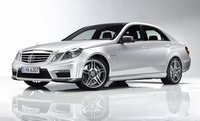Mercedes-Benz New E-Class Addresses Drowsy Driving, a Major Contributor to Vehicle Crashes - VIDEO ENHANCED
More than 100,000 crashes each year are caused by fatigued drivers
MONTVALE, NJ - June 23, 2009: Drowsy driving is one of the most vexing problems involving traffic safety with more than 60 percent of working Americans admitting to driving while feeling sleepy and 37 percent to actually falling asleep at the wheel, in the past year according to the 2008 National Sleep Foundation's Sleep in America poll. The all-new 2010 Mercedes-Benz E-Class addresses this growing issue with state-of-the-art drowsy driving technology called ATTENTION ASSIST.
"Most drivers underestimate the dangers of drowsy driving," said Darrel Drobnich, chief program officer of the National Sleep Foundation. "While nothing replaces a good night's sleep, new automotive technologies that make drivers aware of their lack of alertness can make a significant difference in the number of tragic incidents that occur on American roads."
Drowsy driving causes more than 100,000 police-reported crashes, resulting in 1,550 deaths and another 71,000 injuries each year according to the National Highway Traffic Safety Administration. The problem is significant enough that several states are considering legislation that would allow police to charge drowsy drivers with criminal negligence. New Jersey is currently the only state that specifically criminalizes drowsy driving in a fatal crash by classifying it as recklessness under its vehicular homicide statute.
For this reason, Mercedes-Benz, a leader in vehicle safety technology, created ATTENTION ASSIST, a drowsiness-detection system and made it standard equipment on the new 2010 E-Class. Several years of research and engineering by Mercedes-Benz revealed that drowsy drivers have trouble steering a precise course in their lane, making minor steering errors that are often corrected quickly and abruptly. This effect occurs at an early stage when drowsiness kicks in -- often before the dangerous microsleep phase.
Mercedes-Benz closely studied the physiological indicators in more than 550 male and female drivers that occur when fatigue becomes a factor when driving. These in-depth studies led to the development of technology to monitor driver and vehicle variables and provide a safety alert if drowsy driving is detected.
The ATTENTION ASSIST system includes highly sensitive sensors that continuously monitor and observe the driver's steering behavior across 70 different parameters which prove to be a very strong measure of the driver's condition. Among the monitors is a highly sensitive steering angle sensor that recognizes patterns of minor steering corrections. Once the system recognizes a drowsy driving pattern it emits an audible and visible warning -- in the form of an espresso cup icon in the instrument cluster.
Research has identified the following groups as high-risk for drowsy driving:
• Young people -- sleep-related crashes are most common in young people, who tend to stay up late, sleep too little and drive at night. People 25 years old and under account for 55 percent of fall-asleep crashes with 78 percent being caused by male drivers.
• Shift workers, those working long hours or business travelers -- night shift workers are six times more likely to fall asleep at the wheel and those working more than 60 hours a week are four times more likely. Business travelers who spend many hours driving as part of their job or encounter jet lag after long flights are also at serious risk for drowsy driving.
• Commercial drivers -- account for at least 15 percent of all fatigue-related crashes involving heavy trucks given high mileage trips and night driving when the body is sleepiest.
• Drivers with undiagnosed or untreated sleeping disorders -- such as obstructive sleep apnea have up to a seven times increased risk of falling asleep at the wheel. Sleep apnea occurs in four percent of middle-aged men and two percent of middle-aged women. Most people with this sleep and breathing disorder remain undiagnosed.
At one time or another, fatigue will affect all drivers. Anyone who drives is at risk of falling asleep at the wheel. Just like alcohol and drugs, fatigue impairs judgment, mood, reaction times and driving performance. In fact, studies show that being awake for more than 20 hours results in an impairment equal to a blood alcohol concentration (BAC) of 0.08%, the legal limit in all states.
Short naps and caffeine can improve alertness and driving performance. If a driver feels sleepy, taking a fifteen minute nap followed by ingesting the amount of caffeine in two cups of coffee can help ward off the effects of fatigue for a couple hours. A nap and caffeine is not a substitute for a good night's sleep but they may keep a driver alert until they can get to a stop for the night.
The 2010 Mercedes-Benz E-Class arrives in U.S. dealerships June 2009 and will start at $48,600. Additional information on the all-new E-Class can be found at www.mbusa.com/e-class.
Click PLAY to watch The Auto Channel's in-depth RoadTrip video about the new E 350
About the National Sleep Foundation
National Sleep Foundation (NSF) is a nonprofit organization dedicated to
improving sleep health and safety by achieving greater awareness of sleep
and sleep disorders through education and advocacy. NSF's membership
includes researchers and clinicians focused on sleep medicine as well as
other professionals in the health/medical/science fields, patients, people
affected by drowsy driving, individuals, and more than 1000 healthcare
facilities throughout North America that join the Foundation's Sleep Care
Center Membership Program. For more information visit
www.sleepfoundation.org.



